Before the mid-eighteenth century the only means of crossing the River Tweed at Kelso was by ferry. Not only was this dangerous during bad weather, but it also limited the volume of traffic coming into the town from the south. There was no bridge over the Tweed between Peebles and Berwick and plans were already in place for the Bridge at Kelso when the Lodge’s involvement is recorded in their first minute book. In 1752 a public subscription, supplemented by generous donations from the Kelso Masonic Lodge, paid for the building of a six-arched bridge at a cost of £3,000.
Accounts of the time record that the laying of the foundation stone of the bridge in 1754 was largely arranged by members of the Masonic Lodge. Every working mason in Kelso volunteered a day’s labour on the bridge, and when the bridge opened, they paraded through the town with a band, and even had special medals struck to commemorate the day.

The old Lodge of Kelso’s first minute book covers the period from the 27th December 1701 to the 5th February 1753. It records the activities of one of Scotland’s, if not the world’s, oldest Lodges from its beginning in the late 17th century. The last minutes of this first book, chronicles what was a significant time in the Lodges development which still resonates today.
The first mention of a Bridge over the River Tweed at Kelso was in the minute of 27th December 1752, which ends with a reply to a letter from Dr John Rutherford Master of the Melrose Masonic Lodge – Ye Ludge of Melros 1bis
“Dr Rutherford of Fadinside (The name Fadinside appears to be an older or variant spelling of Faldonside) as Chairman of the Gentlemen concerned in carrying on a subscription for the building of a Bridge over Tweed at Melrose, craved Kelso’s assistance to subscribe to the building of the Bridge at Melrose. However, the Lodge would not consider this request until they had contributed towards building the intended Bridge at Kelso on the River Tweed. The Lodge voted almost unanimously a sum of £50 to that end recommending members who were Doctors to ensure monies were available in case it was called for. The Lodge voted unanimously £5 sterling for the Melrose Bridge.”
(Dr Rutherford owned the Faldonside estate on the south side of the Tweed near Melrose in the Scottish Borders. Hence his involvement in organising a subscription to fund the construction of a bridge over the River Tweed at Melrose. Rutherford was the maternal grandfather of the famed writer Sir Walter Scott, who spent part of his childhood at Rutherford’s estate, Faldonside.)
At the next minute dated 30th November 1753, St Andrews Day, a letter is read from Grand Lodge regarding obtaining a Charter and the expense for the Patent of Confirmation. Following link covers this in more detail – Our Charter dated 6th February 1754. Having obtained the Charter, the Grand Lodge in Edinburgh would now be involved with the Kelso Bridge and all the pomp and ceremony of befitting the occasion.
The bridge over the Tweed at Kelso, being in the course of construction the next pages cover the events leading up to the Laying the Foundation Stone of Kelso Bridge.
“ The gentlemen of the Committee for building the Bridge over Tweed at Kelso, having appointed Monday the 17th of June next for laying the foundation stone of said Bridge, and having desired that the same be done by this Lodge—it is therefor unanimously resolved and agreed upon that this Lodge do meet the 17th of June at the Town-house in order to make a Procession, and lay the foundation stone accordingly, and desire their Secretary to write Letters to the absent members that they may attend that day. And that the whole Lodge may be clothed with new Aprons and Gloves to be pay’d out of General fund of the Lodge, and appoint Deacon Jerdan to provide Gloves and Aprons for that day a Patern of which are to be shon to Doctor Ormstn, Mr Pringle, and David Robertson who are to approve of the same, and the price of Gloves not to exceed ten pence—and remit to John Waldie Vintner to fitt the Apron for the Office Bearers—and Recommend at the same time to the Master, Doctor Ormston, Messrs Pringle and Robertson to order such Musick as they shall think propper, and advise what other Solemnity shall be thought necessary on that occasion, so that all may be conducted in the most regular and decent manner—And appoint Charles Swinton to provide what liquor may be necessary on that occasion.
The Master adjourns the meeting, to the 17th day of June, and appoints Doctor Ormiston, Mr Pringle, Da. Robertson, James Hardie, John Waldie Vintner to meet as a commite in the Lodge at 10 a.m. to prepare matters for the Procession and dispatch other things needful.
(Signed) Ja. Lidderdale M.”
This next extract from the minute book describes the whole procedure for the laying of the foundation stone,
“Kelso June 17th a.m. The Commits mett according to appointment. with Right Worshipful Master who presented to them Letter addressed to him from the Right Worshipful Walter Ferguson Master of the Cannongate Lodge Kilwinning from Leith dated the 14th Instant, authorising Brother Alexander Palmer of that Lodge to act as Master, and Brother Samuel Brown and Geo Sim as wardens therof which letter is appointed to ly among the Records. He likewise produced a Letter of the 15th curt from the Right Worshipful James Reeeh* Master of the Lodge of Mary’s Chapel, signifying he had deputed Brother “William Butter to represent that Lodge with Whom there came other members vis Brothers Ramsay & Thompson.
There likewise appeared Brothers David Baits and John Patterson Esqrs members of the Lodge of St John Cannongate without any special Recommendation from their Lodge in order to join in the Procession.
There likeways appeared Brother John Fergus deputed by the Most Worshipful the Grand Master of Scotland who produced to the Right Worshipful of this Lodge a deputation from the Most worshipful Charles Hamilton Gordon Esqr Grand Master of Scotland, and the Grand Lodge thereof, nominating, constituting and appointing the Right Worshipful James Lidderdale Esqr present Master of the Lodge of Kelso, as Substitute Grand Master in that part, with full powers as therein mentioned. Dated at Edr 15th June 1754″
On the next page of the minute book the Lodge Secretary copies the document issued by Grand Lodge which grants Brother Lidderdale full Power, Warrant and Permission, to Act & proceed as Grand Master Mason at laying the said foundation stone.

Above is the actual document issued by the Grand Lodge of Scotland
and shown below is a modern facsimile of the Warrant
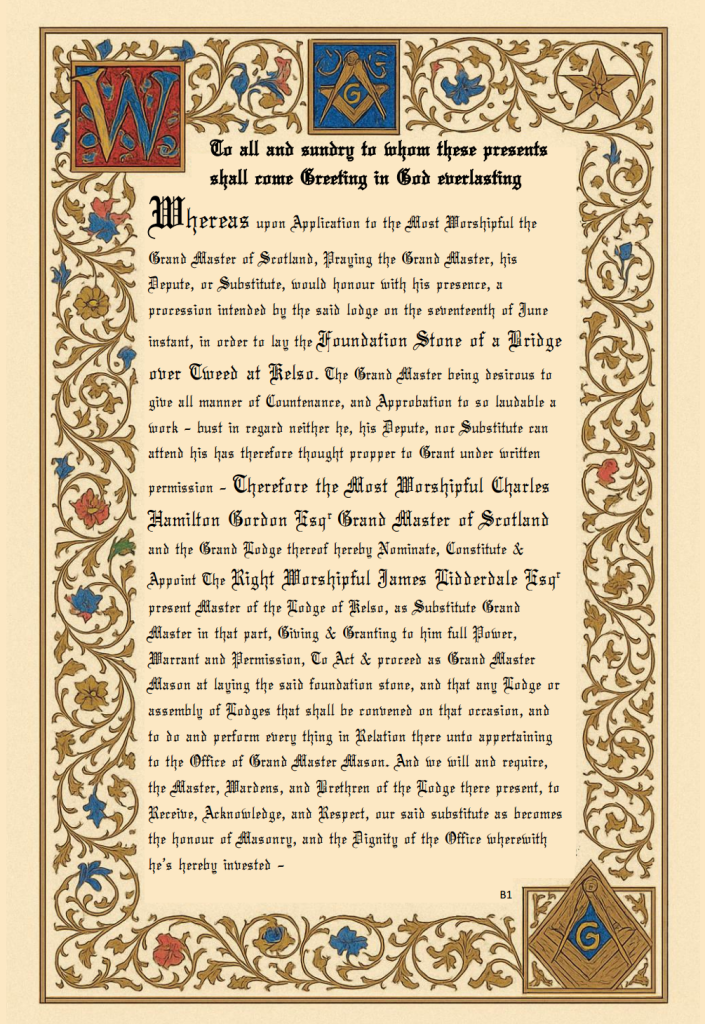
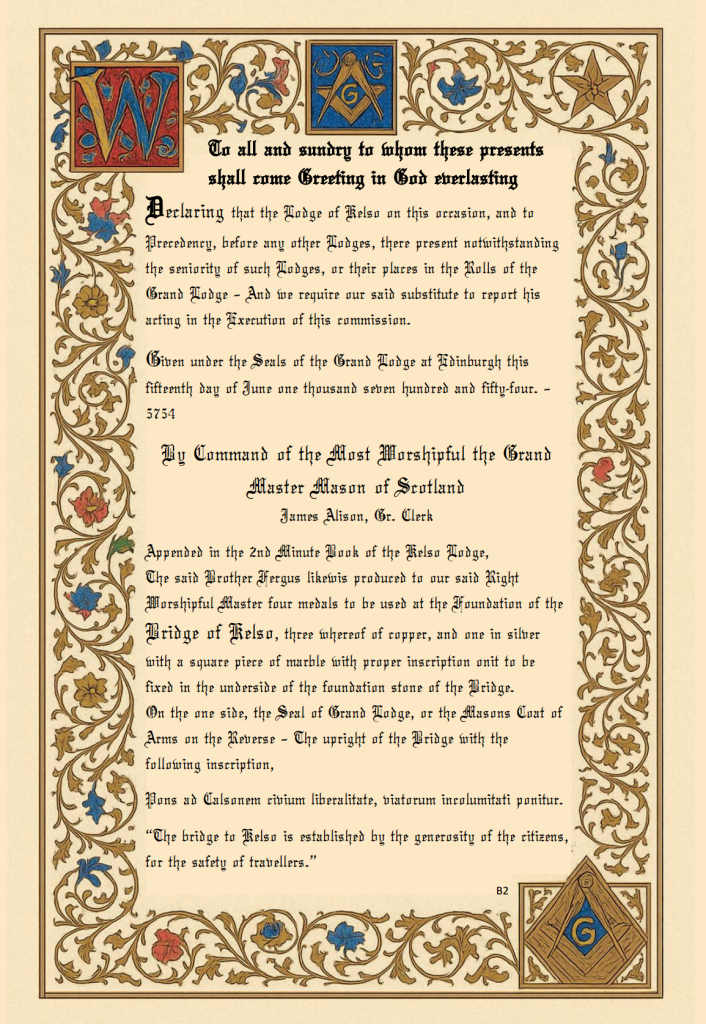
The minute continues,
“The said Brother Fergus likewis produced to our said Right Worshipful Master four medals to be us’d at the foundation of the Bridge of Kelso, three whereof of copper and one in silver with a square piece of marble with a propper Inscription on it to be fixt in the underside of the foundation stone of the Bridge. On the one side, the seal of the Grand Lodge or the Masons Coat of Arms.
On the reverse, The upright of the Bridge, with the following Inscription-
Pons ad Calsonem Civium Liberalitate, Viatorum Incolumitati Ponitur.
(A bridge to Kelso is built by the generosity of the citizens, for the benefit of travellers. 1754)
Upon the Foundation Stone
Stabit opus melius si bene fixa Basis
(The work will stand the better if the foundation is laid securely)
Imperiique Georgii 2d Britanniarum Regis Anno
XXVII
(In the 27th year of the Reign of George II, King of Britain 27)
Upon the Marble Stone
F. D. O. M.
(Filius/Dux/Ornatissimus Memoriae or more commonly: “Filius Dei Omnipotentis”
“Son of Almighty God”
Auctoritate Amplissimi viri Caroli Hamilton Gordon
Socieratis Architectonicae in Scotia
Magistri Summi
Abstantibus curice Colsoensis
Fratribus Architectonicae Universis
Lapis Hicce
Pontis ad Colsonem Principium
Ponitur
XV. KAL IVL. MDCCLIV
Era Architectonicae VMDCCILIV
(By command of that most distinguished man Charles Hamilton Gordon, Grand Master of the Masonic Society in Scotland; all the brethren of the Kelso Masonic Lodge being present. This stone, the foundation of Kelso Bridge is laid 17th July 1754 and of the Masonic Aera 6754)
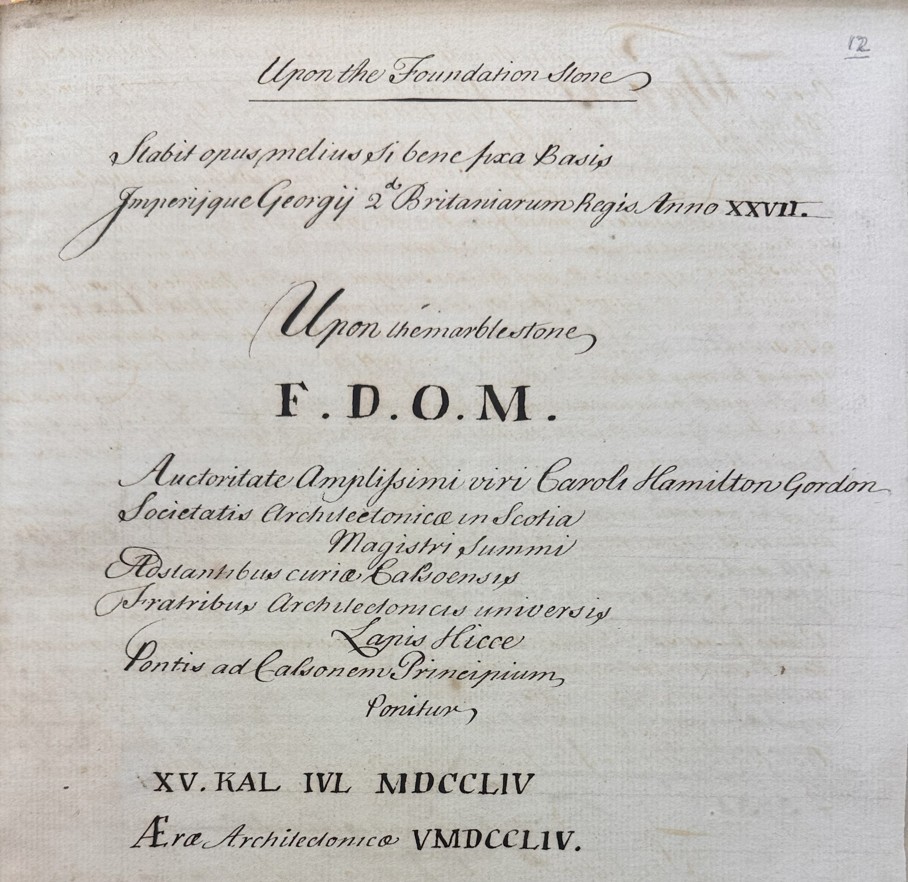
Image of the original page of the minute book
The Lodge thereafter proceeded to admit Ralph Walker overseer employed for the Bridge of Kelso as an apprentice who hereby gives his obligation for the payment of £1 11s 6d sterling to the Lodge next St Johns Day as also 2 sh. sterling speaking money, a mark, and half a crown for being recordid in the Books of the Grand Lodge and chose for his Intenders Thomas Walker and Will Cockburn.

Image of the original entry in the Cash Book, 17th June 1754
There was likewise produced the jewels of the Grand Lodge with the Stewards Rods to be used at the Procession, and authorised the Treasurer to pay the several accompts due for the new Sashes commissioned for the Office-bearers, with the Ribbons, Masters Gloves, and Apron, and an acct. to the Taylor for mounting Aprons to the Office-bearers, with what money the Master has pay’d out for the Charter more than he has received and for running Expresses to Edr. for Musick &c., and other things needful at the Procession according to the accompt given in extending to the sum of —– and then the Lodge adjourned till three afternoon.
Eodem die post meridiem
(On the same day)
The Office Bearers repaired to the Right Worshipful’s Lodgings and being propperly cloth’d attended him from his house to the Town Hall where they were joined by the other members of their Lodge, as also by John Henderson of Lerston, member of the Grand Lodge, and by the Revd. Mr Robert Monteith minister of the Gospel at Longformacus member Grand Lodge, Mr John Cleghorn member of ——– with a band of Musick from Edinburgh consisting of two French horns two Hautboys and a Basson all Brethren and members depending on the Grand Lodge.
The Lodge being tyled, the Master gave order for the same to be opened, whereupon the Right Worshipful produced the above mentioned commission from the Most Worshipful Grand Master for Scotland nominating and appointing him to act as Substitute Grand Master at the foundation laying as by the Tenor above written, which was read accordingly.
Order of Procession
In this manner they proceeded to the place where the foundation Stone was to be laid, and so soon as the Master and Brethren had Ceremony placed ymselves in propper Order, they ordered the Musick to play the Anthem alone, which was afterward sung by some of the Brethren, all the musical Brethren joining in the Chorus, then the Treasurer delivered the medals to the Senior Warden, who delivered them to the Substitute Grand Master, which were put by him into the foundation-stone, the silver one on the inside and the copper ones on each side. Then the piece of marble with the Inscription on it was fixed in the under part of the foundation-stone, in a place hollowed out thereof on purpose. Then the master builder, with the assistance of some operatives, proceeded to lay the stone in its Bed, during which time the musick again play’d ye anthem, Then the Golden Tools, being laid upon a Table before the master, placed to the East of where the stone is to be laid, here the music stops, and the operative who carried the square delivered the same to the substitute, who us’d the square in like manner. Then the operatives who carried the level and Plumb delivered the same to be used as above. After the stone was proven, the master builder delivered the mallet to the Substitute, with which he gave three knocks upon the stone, and then pronounced the following words:
‘God’s good Greeting be with this our happy meeting
And success to this our happy undertaking.’
Then the Brethren performed the honours of masonry by giving three loud claps and huzas, and then the Anthem was play’d. The substitute, returning to his former Post on the East of the Table, address’d himself in a short speech to the Subscribers and Directors then present, to the Inhabitants of the Place and to the master builder and people under his cure, then the honours of masonry were performed as above. Then the whole Returned in the same order, and in due form, with the Right corner of their aprons tucked up till they came to the Town House where they drew up in two Lines, and inverted their procession into the Town Hall, those that went formerly last going in first, during which time the Musick continued playing, ‘till the Brethren were seated, and served by the Stewards, after which the Substitute Grand Master desired leave of the Brethren that he might retire a little with his Deputy to the Balcony of the Town House, in order to propose Drink three Bumper Toasts with the Trades and other Inhabitants of the Town of Kelso, who were drawn up in the Mercat Place, with Tables and Liquor before ym waiting for that Purpose, which they approved of. And he accordingly retired to the Balcony aforsaid and drank a health to His Majesty, a health to his Grace the Duke of Roxburghe, and a third to the success and prosperity of the Bridge, each of which was accompanied with three loud huzas of all present, a flourish of the Musick and a Roll of the Drums.
The Depute Grand Master and others with him return’d to their seats, where they continued for some time, with Musick, and Harmony common among Masons, and notwithstanding the prodigious Crowd of Spectators, the whole was accompanied without any unfortunate accident. A Committee was appointed to inspects the minutes and accompts relating to the Procession, then the Lodge was closed in due form and adjourned to next Quarter day.
Signed Ja Lidderdale Mr”
Just two years later, on 22nd October 1756, one of the central arches of the bridge collapsed, tragically killing six people. The failure was likely due to poor foundations and inherent structural weaknesses. Although the bridge was repaired, the work appears to have been limited—sufficient only to allow basic traffic to continue. Remarkably, the bridge remained in use for the next 40 years, serving as a vital crossing despite ongoing concerns about its stability. In October 1797, following severe flooding, the weakened structure was finally swept away and completely destroyed.
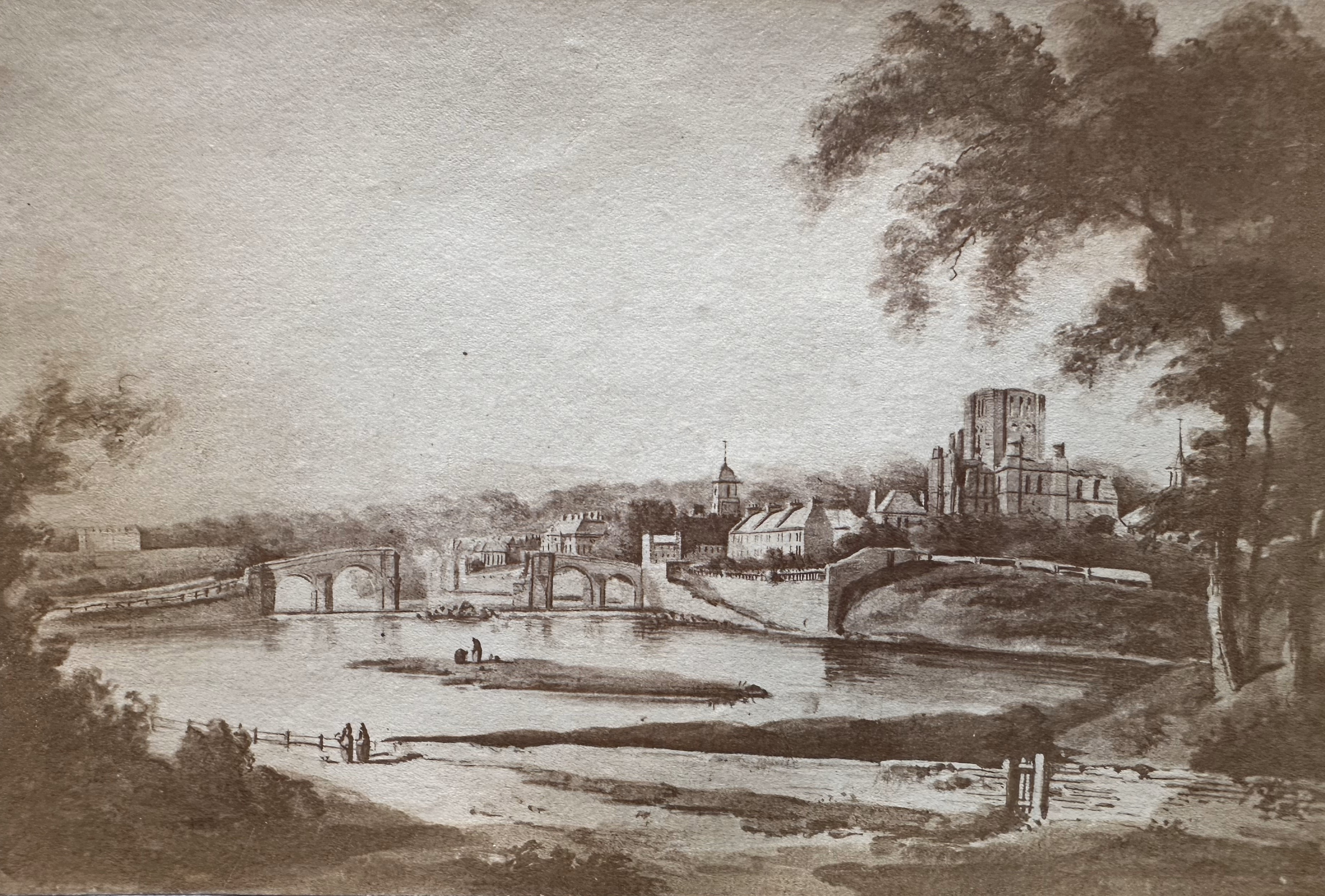
Ruins of the Old Bridge after the flood of 1797.
From the original by Bro. W.Wilson, a member of the Kelso Lodge.
Picture last in the possession of the late Bro W. Fred Vernon, Bowmont House, Kelso.
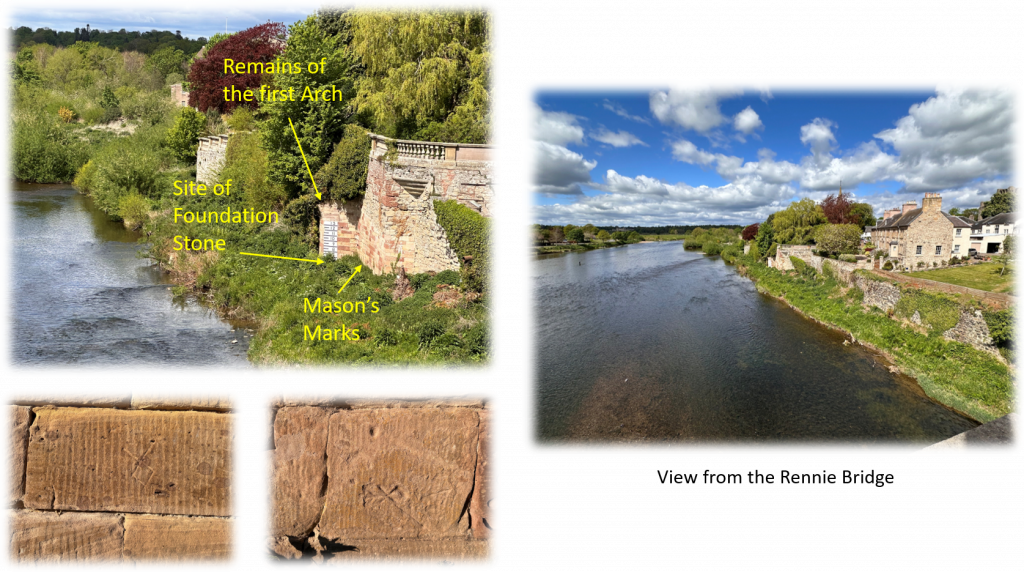

The foundation stone of the old Kelso Bridge was exposed by Dr Derek Robeson in the summer of 2022.
It’s now covered over again with silt and undergrowth.
Stabit opus melius si bene fixa Basis
(The work will stand the better if the foundation is laid securely)
Imperiique Georgii 2d Britanniarum Regis Anno
XXVII
(In the 27th year of the Reign of George II, King of Britain 27)
References: The History Of Freemasonry In The Province of Roxburgh, Peebles and Selkirkshires, From 1674 To The Present Time, by W Fred Vernon
1475 Tweed Bridge (Peebles)
1611 Berwick Bridge
1624 Berwick Bridge
1754 Kelso (Old Bridge)
1762 Melrose Bridge
1766 Coldstream Bridge
1780 Drygrange Old Bridge
1797 Kelso (Old Bridge)
1803 Kelso Bridge
1820 Union Chain Bridge
1841 Mertoun Bridge
1847 Royal Border Bridge
1850 Royal Border Bridge
1928 Royal Tweed Bridge
1998 Hunter Bridge
Likely constructed by John of Peebles
Construction begins on the 15-arch stone bridge
Completed and opened for use
First bridge built across the Tweed bewteen Peebles and Berwick
Bridge project initiated by Dr. John Rutherford
Completed, important route between Edinburgh and London
Completed, now serving as a pedestrian bridge
Old bridge destroyed by flood
New bridge by John Rennie completed
World’s longest suspension bridge at the time opens
Completed, opened to traffic
Construction begins on Stephenson’s viaduct
Opened for railway use
Opened as new main road crossing at Berwick
Forming part of the Kelso bypass